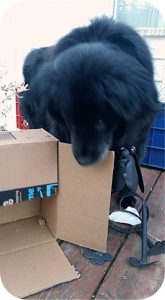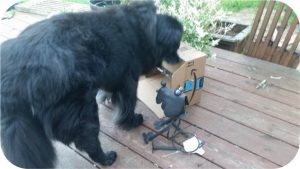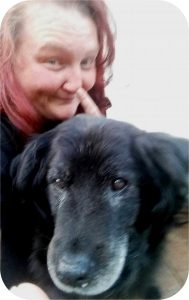Let’s Get Nosey
By Tonya Kniest
I have been a Final Refuge foster with Old Dog Haven for a little more than two years now, and have my second senior, Teddy. Because the special needs pups get so much time and attention, my resident dog, Buddy, sometimes gets pushed to the back of the pack, so to speak. He’s almost nine himself, and boy do their lives pass faster than we want them to. So I recently joined a Nose Work course with him to give us some one on one bonding time. If you haven’t heard of it, think of police dogs, drug sniffing dogs in airports, search and rescue, or any of the many ways we use the amazing scenting capabilities of dogs. In the case of “civilians”, Nose Work can be a competitive sport with trials, or even just a game played in the house or yard to engage the dog and give them something to do.
The basic idea starts with several small-ish boxes (your Amazon addiction now has justification) and some high value dog treats: chicken, cheese, hot dogs. Things that are way tastier than kibble or crunchy, dry treats. A piece of the treat is put in a few of the boxes and spread around a small area, with the other boxes being empty. A verbal cue is given to begin the search. Buddy’s is “Get Nosey!” Some people use “Go to work!” It’s just something short to indicate the game has begun. As the dog finds the loaded box, his human immediately goes to him with more treats and lots of praise. In advanced training, a non-food odor may be introduced to search. With practice, the boxes can be hidden so that the dog has to truly use his nose to search and his brain to problem solve – to figure out how to get that box up on the back of the couch or the one hidden behind the bathroom door. Here it’s worth noting that this is a 100% positive training game. That means not saying NO; that in the house, a searching dog might climb on the couch or bed even if that’s not usually allowed. Basically, everything is about the enthusiasm for the game.
In the first week of my course, instructor Alecia Elvstad (Nose Work Magic, Ferndale, WA) said something that gave me a bit of an “aha!” To paraphrase: dogs begin their lives dependent on scent—finding their mother to nurse, identifying their siblings—before they can even see. And when they are old, it is the last of their senses to fail. They may be blind due to cataracts, deaf due to aging, but that sniffer continues to do its job. That was the case with Teddy not long ago. I dropped a small piece of peanut butter cookie behind a chair, and was amused as he contorted his arthritic body any way he could to wedge himself under the chair to sniff, sniff, sniff out the nibble. That gave me the second “aha!”

 I used what I learned in Buddy’s class and modified a bit because Teddy is deaf. He still has vision, but with cataracts beginning his sight isn’t the greatest. We started in my bedroom, a small space that would guarantee success to start for him, and spread seven or so boxes around, with a treat in each. I brought him into the room, made eye contact, and began tapping my nose repeatedly. Once he got to the box with the treats, I’d pat his sides and rub his back, while putting additional rewards into the box, so he knew he’d done something great. It took no time for him to figure out that the nose tap meant to start sniffing, and every time he found a goodie in a box he’d get an additional reward. We moved on to only having treats in a few of the boxes, then not in boxes but hidden. We also took it to larger areas, like the deck outside. Since he’s 13 with the usual senior mobility issues, I keep the hides accessible so that he does not need to climb or jump.
I used what I learned in Buddy’s class and modified a bit because Teddy is deaf. He still has vision, but with cataracts beginning his sight isn’t the greatest. We started in my bedroom, a small space that would guarantee success to start for him, and spread seven or so boxes around, with a treat in each. I brought him into the room, made eye contact, and began tapping my nose repeatedly. Once he got to the box with the treats, I’d pat his sides and rub his back, while putting additional rewards into the box, so he knew he’d done something great. It took no time for him to figure out that the nose tap meant to start sniffing, and every time he found a goodie in a box he’d get an additional reward. We moved on to only having treats in a few of the boxes, then not in boxes but hidden. We also took it to larger areas, like the deck outside. Since he’s 13 with the usual senior mobility issues, I keep the hides accessible so that he does not need to climb or jump.
Alecia told us that dogs can smell the equivalent of one rotten apple in 13 billion barrels of apples. Billion! So to watch my sweet old guy “get nosey”, understanding my nose tap cue to search, then sniffing an area and suddenly doing an about face because his nose located a scent, then getting closer and closer till he found it, is absolutely thrilling. Maybe even for me more than him.
It might seem like just a way to give a dog a treat, but it’s so much more. By doing this with an older dog, regardless of their training history, they’re getting praise and being told they’re doing something right. In the case of many of our Old Dog Haven Final Refuge fosters who have had neglectful pasts, this is excellent for reminding them they are good dogs. It certainly deepens our bond with them. Even more, the connection between the nose and brain gets those synapses connecting and endorphins flowing, so an old dog with early Canine Cognitive Dysfunction (CCD), aka doggie dementia, can get some mental stimulation that might just slow down the decline.
If nothing else, it’s just plain fun!
If you’d like to try a course or workshop yourself, check out the National Association of Canine Scent Work at https://www.nacsw.net/.
For more tips on playing the basic game at home, read this excellent article. http://www.dogstardaily.com/blogs/getting-started-nose-work


